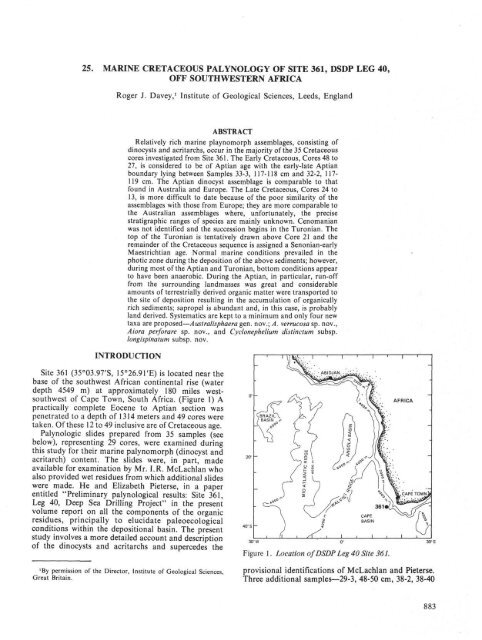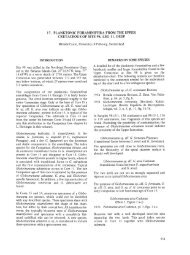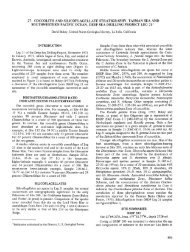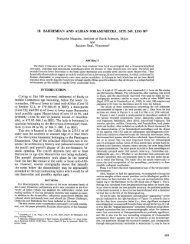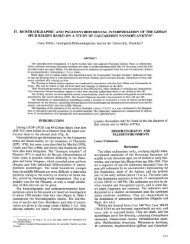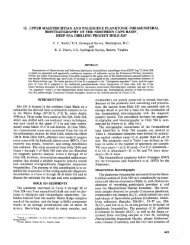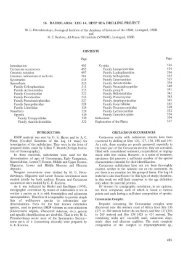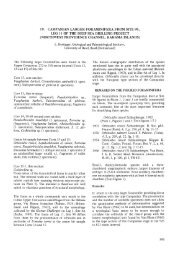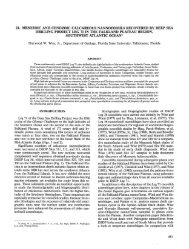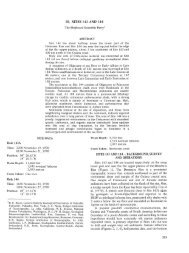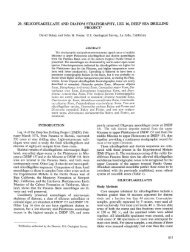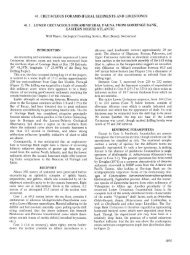25. Marine Cretaceous Palynology of Site 361, DSDP - Deep Sea ...
25. Marine Cretaceous Palynology of Site 361, DSDP - Deep Sea ...
25. Marine Cretaceous Palynology of Site 361, DSDP - Deep Sea ...
Create successful ePaper yourself
Turn your PDF publications into a flip-book with our unique Google optimized e-Paper software.
<strong>25.</strong> MARINE CRETACEOUS PALYNOLOGY OF SITE <strong>361</strong>, <strong>DSDP</strong> LEG 40,<br />
OFF SOUTHWESTERN AFRICA<br />
Roger J. Davey, 1 Institute <strong>of</strong> Geological Sciences, Leeds, England<br />
ABSTRACT<br />
Relatively rich marine playnomorph assemblages, consisting <strong>of</strong><br />
dinocysts and acritarchs, occur in the majority <strong>of</strong> the 35 <strong>Cretaceous</strong><br />
cores investigated from <strong>Site</strong> <strong>361</strong>. The Early <strong>Cretaceous</strong>, Cores 48 to<br />
27, is considered to be <strong>of</strong> Aptian age with the early-late Aptian<br />
boundary lying between Samples 33-3, 117-118 cm and 32-2, 117-<br />
119 cm. The Aptian dinocyst assemblage is comparable to that<br />
found in Australia and Europe. The Late <strong>Cretaceous</strong>, Cores 24 to<br />
13, is more difficult to date because <strong>of</strong> the poor similarity <strong>of</strong> the<br />
assemblages with those from Europe; they are more comparable to<br />
the Australian assemblages where, unfortunately, the precise<br />
stratigraphic ranges <strong>of</strong> species are mainly unknown. Cenomanian<br />
was not identified and the succession begins in the Turonian. The<br />
top <strong>of</strong> the Turonian is tentatively drawn above Core 21 and the<br />
remainder <strong>of</strong> the <strong>Cretaceous</strong> sequence is assigned a Senonian-early<br />
Maestrichtian age. Normal marine conditions prevailed in the<br />
photic zone during the deposition <strong>of</strong> the above sediments; however,<br />
during most <strong>of</strong> the Aptian and Turonian, bottom conditions appear<br />
to have been anaerobic. During the Aptian, in particular, run-<strong>of</strong>f<br />
from the surrounding landmasses was great and considerable<br />
amounts <strong>of</strong> terrestrially derived organic matter were transported to<br />
the site <strong>of</strong> deposition resulting in the accumulation <strong>of</strong> organically<br />
rich sediments; sapropel is abundant and, in this case, is probably<br />
land derived. Systematics are kept to a minimum and only four new<br />
taxa are proposed—Australisphaera gen. nov.; A. verrucosa sp. nov.,<br />
Aiora perforare sp. nov., and Cyclonephelium distinctum subsp.<br />
longispinatum subsp. nov.<br />
INTRODUCTION<br />
<strong>Site</strong> <strong>361</strong> (35°O3.97'S, 15°26.91'E) is located near the<br />
base <strong>of</strong> the southwest African continental rise (water<br />
depth 4549 m) at approximately 180 miles westsouthwest<br />
<strong>of</strong> Cape Town, South Africa. (Figure 1) A<br />
practically complete Eocene to Aptian section was<br />
penetrated to a depth <strong>of</strong> 1314 meters and 49 cores were<br />
taken. Of these 12 to 49 inclusive are <strong>of</strong> <strong>Cretaceous</strong> age.<br />
Palynologic slides prepared from 35 samples (see<br />
below), representing 29 cores, were examined during<br />
this study for their marine palynomorph (dinocyst and<br />
acritarch) content. The slides were, in part, made<br />
available for examination by Mr. LR. McLachlan who<br />
also provided wet residues from which additional slides<br />
were made. He and Elizabeth Pieterse, in a paper<br />
entitled "Preliminary palynological results: <strong>Site</strong> <strong>361</strong>,<br />
Leg 40, <strong>Deep</strong> <strong>Sea</strong> Drilling Project" in the present<br />
volume report on all the components <strong>of</strong> the organic<br />
residues, principally to elucidate paleoecological<br />
conditions within the depositional basin. The present<br />
study involves a more detailed account and description<br />
<strong>of</strong> the dinocysts and acritarchs and supercedes the<br />
'By permission <strong>of</strong> the Director, Institute <strong>of</strong> Geological Sciences,<br />
Great Britain.<br />
3o°w 0°<br />
Figure 1. Location <strong>of</strong> <strong>DSDP</strong> Leg 40 <strong>Site</strong> <strong>361</strong>.<br />
provisional identifications <strong>of</strong> McLachlan and Pieterse.<br />
Three additional samples—29-3, 48-50 cm, 38-2, 38-40<br />
883
R. J. DAVEY<br />
cm, and 44-2, 111-113 cm—were subsequently acquired<br />
from SOEKOR and incorporated into the study.<br />
All slides <strong>of</strong> type material with the prefix MPK and<br />
slides labeled CSA are housed in the Palynological<br />
Collection, Institute <strong>of</strong> Geological Sciences, Leeds,<br />
England. The slides borrowed from SOEKOR are now<br />
in their palynology laboratories, Johannesburg, South<br />
Africa. The co-ordinates <strong>of</strong> all specimens are from the<br />
Zeiss rotating and centering mechanical stage 50/75,<br />
number 4896 472, IGS, Leeds.<br />
SAMPLES EXAMINED<br />
Table 1 lists the samples examined during the present<br />
study. The SOEKOR numbers refer to samples also<br />
analyzed by McLachlan and Pieterse (this volume).<br />
PALYNOLOGICAL RESULTS<br />
General Discussion<br />
On the basis <strong>of</strong> this investigation the <strong>Cretaceous</strong><br />
sequence can be divided into two parts, one <strong>of</strong> Early<br />
<strong>Cretaceous</strong> and one <strong>of</strong> Late <strong>Cretaceous</strong> age. The<br />
palynological residue from the Early <strong>Cretaceous</strong> is<br />
dominated by sapropelic organic matter, coarse<br />
884<br />
l.G.S.<br />
Sample No.<br />
(CSA)<br />
1725<br />
1726<br />
1727<br />
1728<br />
1729<br />
1730<br />
1731<br />
1732<br />
1733<br />
1734<br />
1735<br />
1736<br />
1737<br />
1738<br />
1739<br />
1740<br />
1741<br />
1742<br />
1743<br />
1744<br />
1745<br />
1746<br />
1747<br />
1748<br />
1749<br />
1750<br />
1751<br />
1752<br />
1753<br />
1754<br />
1755<br />
1756<br />
1757<br />
1758<br />
1759<br />
TABLE 1<br />
Samples Examined<br />
SOEKOR <strong>Palynology</strong><br />
Sample No.<br />
4978<br />
4983<br />
4984<br />
4985<br />
4986<br />
4987<br />
4988<br />
4989<br />
4990<br />
4991<br />
4993<br />
4995<br />
4997<br />
4998<br />
5000<br />
5001<br />
5002<br />
5003<br />
5004<br />
5005<br />
5006<br />
5007<br />
5010<br />
5011<br />
5012<br />
5014<br />
5017<br />
5018<br />
5019<br />
5022<br />
5023<br />
5024<br />
Sample<br />
(Interval<br />
in cm)<br />
13-1, 123-125<br />
17-2,51-53<br />
18-2, 140-141<br />
19-2, 143-145<br />
19-4, 91-92<br />
20-2, 144-146<br />
21-2, 131-133<br />
22-2, 92-94<br />
23-2, 61-64<br />
24-2, 96-98<br />
27-2, 119-121<br />
28-6, 115-117<br />
29-3, 48-50<br />
31-4, 129-131<br />
32-2, 117-119<br />
33-3, 117-118<br />
34-2, 60-62<br />
35-2, 130-132<br />
35-3, 50-52<br />
36-1, 103-105<br />
36-2, 136-138<br />
36-3, 77-79<br />
37-2, 129-131<br />
38-2, 38-40<br />
40-2, 87-89<br />
40-3, 99-101<br />
41-1, 90-92<br />
41-3, 53-55<br />
43-2, 116-118<br />
43-3, 12-13<br />
44-2, 111-113<br />
45-1, 134-136<br />
46-2, 124-125<br />
47-1, 128-130<br />
48-2, 134-136<br />
terrestrially derived plant debris and sporomorphs;<br />
marine palynomorphs represent less than 5% <strong>of</strong> the<br />
palynomorph assemblage and are sometimes<br />
apparently absent. However, marine species, although<br />
low in abundance, are <strong>of</strong>ten quite high in diversity and<br />
more than 30 species may be present in an assemblage.<br />
The marine palynomorph assemblage is unusual in that<br />
acritarchs are typically abundant and, in some<br />
instances, outnumber the dinocysts. Micr<strong>of</strong>oraminifers<br />
occur in most samples.<br />
The Late <strong>Cretaceous</strong> palynologic residues contain<br />
markedly less sapropelic organic matter—none at all<br />
in the younger samples—still with a considerable<br />
amount <strong>of</strong> terrestrially derived plant debris but fewer<br />
sporomorphs; marine palynomorphs, particularly<br />
dinocysts, are now generally common and compose up<br />
to 30% <strong>of</strong> the palynomorph assemblage. The number <strong>of</strong><br />
marine species per sample, however, remains broadly<br />
similar to that found in the Early <strong>Cretaceous</strong>. Micr<strong>of</strong>oraminifers<br />
continue to be present but the acritarchs<br />
are considerably less abundant and disappear entirely<br />
higher in the sequence.<br />
Stratigraphic Discussion<br />
The majority <strong>of</strong> the marine palynomorphs recovered<br />
have been previously reported from sediments <strong>of</strong><br />
similar age in other parts <strong>of</strong> the world, notably<br />
Australia and Northwest Europe and, to a lesser extent,<br />
North America. Literature on <strong>Cretaceous</strong> assemblages<br />
from southern Africa, South America, India, and<br />
Antarctica, however, is virtually nonexistent and so<br />
comparison with these and neighboring regions is<br />
impossible. This emphasizes the necessity for a detailed<br />
stratigraphic description <strong>of</strong> the present assemblages<br />
and is the reason for the morphologic and taxonomic<br />
comments made in part 2 <strong>of</strong> the systematics section.<br />
The <strong>Cretaceous</strong> assemblages most closely resemble<br />
those described in many Australian publications and<br />
particularly those from Western Australia. Their<br />
stratigraphic ranges there, however, are not accurately<br />
known because most <strong>of</strong> the assemblages come from<br />
poorly dated boreholes. Thus only tentative dates can<br />
be obtained by comparison even though assemblage<br />
evolution appears to be almost identical in the two<br />
regions.<br />
The European <strong>Cretaceous</strong> assemblages are the better<br />
known even though much still remains unpublished.<br />
The Early <strong>Cretaceous</strong> dinocyst assemblage <strong>of</strong> <strong>Site</strong> <strong>361</strong> is<br />
remarkably similar to that known to occur in France<br />
where the most detailed work has taken place. The Late<br />
<strong>Cretaceous</strong> assemblages are less similar because <strong>of</strong> the<br />
presence <strong>of</strong> several distinctive Australian forms which<br />
are not found in Europe. The stratigraphic ranges <strong>of</strong><br />
species are particularly well known in France and<br />
England and dating <strong>of</strong> the <strong>Site</strong> <strong>361</strong> assemblages is<br />
effected mainly by data from these two countries.<br />
There appears to be a relatively large difference<br />
between the <strong>Site</strong> <strong>361</strong> assemblages and those <strong>of</strong><br />
comparable ages from North America, principally<br />
Canada, and detailed comparison leads to very few<br />
meaningful stratigraphic conclusions.
Cores 48 to 27: Aptian<br />
The marine palynomorph assemblage in these cores<br />
consists <strong>of</strong> dinocysts and acritarchs, the vast majority<br />
<strong>of</strong> which also occur in Europe and Australia (see<br />
Figures 2, 3). Only two <strong>of</strong> the dinocyst species, Dingodinium<br />
cerviculum Cookson and Eisenack (1958) and<br />
"Canningia" ringnesii Manum and Cookson (1964)<br />
have not, as yet, been reported from Europe. Acritarchs<br />
typically outnumber the dinocysts and consist mainly<br />
<strong>of</strong> long-ranging species which are indicative <strong>of</strong> a special<br />
and characteristic marine environment rather than a<br />
certain stratigraphic level (see Paleoecological Considerations).<br />
The dinocyst assemblage as a whole is typical <strong>of</strong> the<br />
European Aptian (Davey and Verdier, 1974) although<br />
several <strong>of</strong> the characteristic and stratigraphically<br />
restricted European species are absent. Davey and<br />
Verdier (1974) indicate that the basal Aptian is characterized<br />
by the incoming <strong>of</strong> Aptea polymorpha<br />
Eisenack, 1958, Cyclonephelium tabulatum Davey and<br />
Verdier, 1974, and Meiourogonyaulax psoros Davey<br />
and Verdier, 1974, and the appearance <strong>of</strong> Protoellipsodinium<br />
spinocristatum Davey and Verdier, 1971, during<br />
the early Aptian. None <strong>of</strong> these species were found<br />
during the present study, and <strong>of</strong> these four species only<br />
P. spinocristatum has been reported from Australia<br />
(Morgan, 1975). In addition the marker species for the<br />
European Barremian (Milliond, 1969; Davey, 1974),<br />
Pseudoceratium pelliferum Gocht, 1957, and<br />
Muderongia staurota Sarjeant, 1966c, are also absent.<br />
Hence it is on rather negative evidence that the base <strong>of</strong><br />
<strong>Site</strong> <strong>361</strong> is dated as Aptian; the possible presence <strong>of</strong> pre-<br />
Aptian strata cannot be completely dismissed.<br />
Higher in the Early <strong>Cretaceous</strong> sequence several<br />
species are stratigraphically important and include, in<br />
alphabetical order, those listed below. It should be<br />
noted that much <strong>of</strong> the subsequent stratigraphic<br />
discussion is based on Davey and Verdier's 1974 study<br />
<strong>of</strong> the type Aptian (France).<br />
1) Achomosphaera neptuni (Eisenack, 1958) and A. cf.<br />
neptuni <strong>of</strong> Davey and Verdier (1974). These occur<br />
spasmodically in the French Aptian but not in the<br />
Albian. The latter form last occurs in Core 27.<br />
2) Cauca parva (Alberti, 1961) has a first stratigraphic<br />
occurrence within the late Aptian <strong>of</strong> France,<br />
and in Core 32.<br />
3) Chlamydophorella huguonioti (Valensi, 1955a)<br />
comb. nov. has a first stratigraphic occurrence at the<br />
base <strong>of</strong> the late Aptian in France, and in Core 32.<br />
4) Dingodinium albertii Sarjeant, 1966c, and D.<br />
cerviculum. The taxonomic controversy surrounding<br />
these two species is discussed in the Systematics<br />
Section. In France the genus ranges to the top <strong>of</strong> the<br />
Aptian, but has never been observed in the Albian<br />
(Davey and Verdier, 1971; Verdier, 1975); it ranges to<br />
the top <strong>of</strong> the Early <strong>Cretaceous</strong> (Core 27) at <strong>Site</strong> <strong>361</strong>.<br />
The distribution <strong>of</strong> D. cerviculum in Australia was<br />
discussed by Haskell (1969) who concluded that its top<br />
stratigraphic occurrence coincided with the top <strong>of</strong><br />
Dettmann's (1963) Speciosus Assemblage Zone and<br />
with the top <strong>of</strong> the Aptian. Burger (in preparation)<br />
erects the D. cerviculum zone and regards it as Aptian<br />
MARINE CRETACEOUS PALYNOLOGY OF SITE <strong>361</strong><br />
(to ?Barremian) age. Burger's succeeding zone in the<br />
succession is that <strong>of</strong> Pseudoceratium turneri Cookson<br />
and Eisenack, 1958, a species which does not occur at<br />
<strong>Site</strong> <strong>361</strong>, and this is considered to be <strong>of</strong> early to middle<br />
Albian age. D. cerviculum does occur rarely in this<br />
younger zone but, discussing these occurrences, Burger<br />
says "many <strong>of</strong> the specimens found are suspected to be<br />
<strong>of</strong> secondary (recycled) origin." Finally, relatively rare<br />
specimens <strong>of</strong> D. cerviculum have been reported from the<br />
Albian <strong>of</strong> Canada by Singh (1971) and Brideaux (1971).<br />
These Canadian occurrences are reminiscent <strong>of</strong> the<br />
younger Australian occurrences and suggest that in<br />
certain regions Dingodinium did linger on into the<br />
Albian.<br />
5) Kleithriasphaeridium simplicispinum (Davey and<br />
Williams, 1966b). In the type Aptian this species has a<br />
top stratigraphic occurrence within the late Aptian; it<br />
last occurs in Core 32.<br />
6) Muderongia cf. staurota Sarjeant, 1966c, <strong>of</strong> Davey<br />
and Verdier, 1974. This form extends into the earlytype<br />
Aptian and is the only Muderongia species to range<br />
into post-Barremian strata in Europe; it occurs rarely in<br />
many <strong>of</strong> the Early <strong>Cretaceous</strong> cores. Muderongia cf. M.<br />
crucis Neale and Sarjeant, 1962, <strong>of</strong> Burger (in preparation)<br />
is probably equivalent to M. cf. staurota and, as<br />
with D. cerviculum, Burger reports that it occurs rarely<br />
up into the early to middle Albian <strong>of</strong> Australia.<br />
7) Muderongia tetracantha (Gocht, 1957) occurs only<br />
in Core 32; in Europe it has been reported from the<br />
Hauterivian <strong>of</strong> Germany (Gocht, 1957) and the early<br />
Barremian <strong>of</strong> England (Sarjeant, 1966c; Davey, 1974).<br />
Haskell (1969) considers that the top stratigraphic<br />
occurrence <strong>of</strong> M. tetracantha coincides with the top<br />
occurrence <strong>of</strong> D. cerviculum and the top <strong>of</strong> the Aptian.<br />
Burger (in preparation) however finds it associated with<br />
M. cf. staurota (as M. cf. M. crucis) and D. cerviculum<br />
in the early to middle Albian.<br />
8) Palaeoperidinium cretaceum Pocock, 1962, first<br />
appears strongly at the top <strong>of</strong> the early Aptian in<br />
France and only occurs in Core 27 at <strong>Site</strong> <strong>361</strong>.<br />
9) Subtilisphaera ventriosa (Alberti, 1959) has only<br />
previously been reported from the so-called early<br />
Aptian <strong>of</strong> Germany by Alberti (1959) in borehole Werle<br />
3 (Westmecklenberg). However, because <strong>of</strong><br />
contamination, reworking and/or caving, no definite<br />
age can be assigned to the reported dinocyst<br />
assemblage.<br />
From the above stratigraphic discussions, it may be<br />
concluded that, at the present time, the most reliable<br />
stratigraphic indices within the Aptian at <strong>Site</strong> <strong>361</strong><br />
appear to be Chlamydophorella huguonioti and<br />
Kleithriasphaeridium simplicispinum. These suggest that<br />
the base <strong>of</strong> the upper Aptian is between Samples 33-3,<br />
117-118 cm and 32-2, 117-119 cm. The occurrence <strong>of</strong><br />
Dingodinium and Achomosphaera cf. neptuni in Core 27,<br />
and the distribution <strong>of</strong> certain other species discussed<br />
above in the sequence, strongly suggests that it is<br />
Aptian in age.<br />
Cores 26 and 25: Age Indeterminate<br />
These cores consist mainly <strong>of</strong> reddish shales and<br />
interbedded siltstones; these are invariably palynologically<br />
barren. McLachlan and Pieterse (this volume)<br />
885
R. J. DAVEY<br />
Figure 2. Distribution chart <strong>of</strong> marine palynomorphs <strong>of</strong> <strong>Cretaceous</strong> age from <strong>Site</strong> <strong>361</strong>.<br />
886<br />
o<br />
AGE WI , J ! I „ ! j « | I I I , |<br />
Z<br />
g in i! 1 iiJJii ,i üllliiil !i ili I i<br />
s IIiiiiflliilJtlilIifiifWiIIIliiJiittlPltilW<br />
"^^^'l^^QUjüü.üiüOUüüüüUüüüOOiJüüüüüüüüüOüùQQQQQQuj^^
MARINE CRETACEOUS PALYNOLOGY OF SITE <strong>361</strong><br />
I<br />
I || || | I |<br />
i•l IL! Ji i i t11 fill! 11 nii
R. J. DAVEY<br />
Figure 3. Range chart <strong>of</strong> marine palynomorphs <strong>of</strong> <strong>Cretaceous</strong> age from <strong>Site</strong> <strong>361</strong>.<br />
888<br />
o h I<br />
O ε I<br />
A G E co fJ i If 1 Illi J
Figure 3. (Continued),<br />
MARINE CRETACEOUS PALYNOLOGY OF SITE <strong>361</strong><br />
I I<br />
. 1 i I<br />
_ |.δ S S I<br />
UH.iUiiliisli .it÷t si J tilii .ill t ill .j<br />
I<br />
• ••<br />
• •••••• ••<br />
"i mil..<br />
l l l l l l • β Φ .<br />
•<br />
—~L.—i i j , , 1—<br />
1 t<br />
i<br />
889
R. J. DAVEY<br />
confirm this when they indicate that Sections 25-3, 26-<br />
3, -4, -5, and -6 are barren. Dinocyst assemblages <strong>of</strong><br />
Albo-Cenomanian age are well known from Europe<br />
and Australia and many distinctive species, such as<br />
Litosphaeridium siphoniphorum (Cookson and<br />
Eisenack, 1958), Hystrichosphaeridium arundum<br />
Eisenack and Cookson, 1960, and genera, such<br />
Ovoidinium Davey, 1970, and Carpodinium Cookson<br />
and Eisenack, 1962b, are typically present. However,<br />
none <strong>of</strong> these forms were found at <strong>Site</strong> <strong>361</strong> which<br />
suggests that the Albo-Cenomanian is either absent or<br />
represented in the paleontologically barren Cores 26<br />
and <strong>25.</strong><br />
Cores 24 to 21: Turonian,<br />
Cores 20 to 13: Senonian to Maestrichtian<br />
Many <strong>of</strong> the dinocyst species present in these cores<br />
are known to occur both in Europe and Australia but a<br />
few species have been previously only recorded from<br />
Australia. As in the Early <strong>Cretaceous</strong>, dating was<br />
effected principally by comparisons with European<br />
assemblages. A detailed stratigraphic study, by the<br />
author and Dr. J.-P. Verdier, <strong>of</strong> the late Albian to<br />
?Santonian in the L<strong>of</strong>fre borehole, northern France, is<br />
in press, and several <strong>of</strong> the datings originate from this<br />
work. Even so, dating <strong>of</strong> the <strong>Site</strong> <strong>361</strong> Late <strong>Cretaceous</strong> is<br />
extremely tentative.<br />
The following stratigraphically useful forms were<br />
recorded; Florentinia resex Davey and Verdier (1976)<br />
occurs in Cores 24 and 23, and in the L<strong>of</strong>fre borehole is<br />
restricted to the early Turonian. Subtilisphaera<br />
pirnaensis (Alberti, 1959), in Cores 23 and 22, is known<br />
to have principally an early to middle Turonian range<br />
in Europe, and Chlamydophorella huguonioti (Cores 23<br />
and 22) ranges to the top <strong>of</strong> the Turonian. Core 21 does<br />
not contain any age-diagnostic European species<br />
although Conosphaeridium striatoconus (Deflandre and<br />
Cookson, 1955), previously found only in Australia, is<br />
considered to have a stratigraphic base in the Turonian.<br />
Core 20 does contain Hystrichisphaeridium sp. A.,<br />
which has a basal occurrence in the Coniacian <strong>of</strong><br />
L<strong>of</strong>fre, and Disphaeria macropyla Cookson and<br />
Eisenack, 1960a, an Australian form, reported to be<br />
principally <strong>of</strong> Coniacian age. A form similar to D.<br />
macropyla occurs in the late Coniacian -? Santonian <strong>of</strong><br />
L<strong>of</strong>fre. Hence, on the evidence available, the Turonian-<br />
Coniacian boundary is tentatively placed between<br />
Samples 21-2, 131-133 cm and 20-2, 144-146 cm.<br />
The comparison <strong>of</strong> assemblages from Cores 20 to 13<br />
with European assemblages is not very meaningful and<br />
only a Senonian to early Maestrichtian age can be<br />
given. Many <strong>of</strong> the species present are restricted to and<br />
characteristic <strong>of</strong> the Australian Late <strong>Cretaceous</strong> and<br />
comparisons can easily be made with some <strong>of</strong> the<br />
described sequences. The most comparable sequence <strong>of</strong><br />
assemblages was described by Cookson and Eisenack<br />
(1960a) from the Turonian to ?Campanian <strong>of</strong> Wapefs<br />
Rough Range South No. 1 bore, Carnarvon Basin,<br />
Western Australia. This publication, and all the many<br />
others these authors have published on Australian<br />
dinocysts, is basically a taxonomic study and it is<br />
impossible to construct a comprehensive distribution or<br />
890<br />
range chart for the species present. Data from<br />
Australia, particularly Western Australia, indicate that<br />
Cores 20 to 13 are <strong>of</strong> Coniacian to Campanian age.<br />
The genus Odontochitina Deflandre, 1935, represented<br />
by O. operculata (O. Wetzel, 1933a) ranges into<br />
the early Maestrichtian <strong>of</strong> Europe (Wilson, 1971) and<br />
suggests that Core 13, although containing a different<br />
species <strong>of</strong>°this genus (O. porifera Cookson, 1956),<br />
could be as young as early Maestrichtian. It is interesting<br />
to note that the characteristic deflandroid species <strong>of</strong><br />
Senonian-Maestrichtian age described from Senegal by<br />
Jain and Millipied (1973), from Gabon by Malloy<br />
(1972) and from Ghana by Davey (in press) were not<br />
found at <strong>Site</strong> <strong>361</strong>.<br />
Paleoecological Considerations<br />
McLachlan and Pieterse (this volume) discuss the<br />
various organic components making up the <strong>Cretaceous</strong><br />
palynologic residues. Of particular interest from a<br />
paleoecological standpoint is their fig. 2 which indicates<br />
the proportions <strong>of</strong> the various constituents. The<br />
following discussion reappraises the palynologic data<br />
available pertaining to the conditions <strong>of</strong> deposition and<br />
type <strong>of</strong> water mass present during <strong>Cretaceous</strong> times<br />
from a slightly different point <strong>of</strong> view.<br />
Aptian(Cores48to27)<br />
The Aptian samples typically yield dinocyst assemblages<br />
which are relatively rich in species but poor in<br />
numerical abundance. The majority <strong>of</strong> these species<br />
also occur in France and Australia. Hence it must be<br />
concluded that at least the photic zone above the site <strong>of</strong><br />
deposition, inhabited by the motile din<strong>of</strong>lagellates, was<br />
<strong>of</strong> near normal salinity and, in addition, that there was<br />
free oceanic connection between northwest Europe,<br />
<strong>Site</strong> <strong>361</strong>, and Australia. Water temperatures were also<br />
probably rather similar in these regions.<br />
The organic residues <strong>of</strong> the Aptian are unusual and<br />
are characterized by an abundance <strong>of</strong> sapropelic or<br />
amorphous organic matter (AOM <strong>of</strong> Davey and<br />
Rogers, 1975) or MOC <strong>of</strong> McLachlan and Pieterse (this<br />
volume) and also by an unusual abundance <strong>of</strong> nonspinose<br />
acritarchs belonging to the genera Pterospermella<br />
Eisenack, 1972, Cymatiosphaera O. Wetzel,<br />
1933b, and Eyrea Cookson and Eisenack, 1971. The<br />
AOM appears to be <strong>of</strong> marine origin in many <strong>of</strong> the<br />
regions where it has been recorded, e.g. the Late<br />
Jurassic <strong>of</strong> England, and in the Recent sediments<br />
<strong>of</strong>fshore from South West Africa (Davey and Rogers,<br />
1975) where it is associated with high marine phytoplankton<br />
productivity resulting from upwelling.<br />
However, in some AOM rich sediments, sporomorphs<br />
predominate over dinocysts. In this situation it is quite<br />
plausible to suggest that the AOM is associated with<br />
the sporomorphs and is <strong>of</strong> terrestrial origin.<br />
The above acritarchs are a facies controlled element<br />
and have only previously been recorded together from<br />
Core 20 <strong>of</strong> the Eyre No. 1 bore, Eucla Basin, Western<br />
Australia (Cookson and Eisenack, 1971). The sediment<br />
here was described as a dark gray mudstone. In other<br />
parts <strong>of</strong> the world these non-spinose acritarchs,<br />
particularly Pterospermella and Cymatiosphaera,
appear to be consistently associated with organic-rich<br />
sediments in the Mesozoic, e.g., in the mid-<strong>Cretaceous</strong><br />
<strong>of</strong> central Canada (Davey, 1970; Singh, 1971), the<br />
Kimmeridgian <strong>of</strong> southern England, and the<br />
Kimmeridgian-Portlandian <strong>of</strong> the northern North <strong>Sea</strong><br />
Basin. These forms do not occur in the Aptian <strong>of</strong> northwest<br />
Europe. The reason for this association is not<br />
known, but a correlation with large run-<strong>of</strong>f from the<br />
landmass and basins with a somewhat restricted<br />
bottom circulation appeared to be indicated.<br />
Sporomorphs are abundant in the Aptian and greatly<br />
outnumber the marine palynomorphs (see McLachlan<br />
and Pieterse, this volume). This palynomorph distribution<br />
is unusual in marine sediments and, together with<br />
the abundance <strong>of</strong> terrestrially derived plant material,<br />
indicates that there was a copious run-<strong>of</strong>f from the<br />
neighboring landmasses which reached the site <strong>of</strong><br />
deposition; it also suggests that the AOM is terrestrially<br />
derived. As the dinocyst assemblage is relatively rich, it<br />
is perhaps easiest to envisage bottom currents bringing<br />
this terrestrial debris to the site <strong>of</strong> deposition.<br />
A final detail is that the chitinous linings <strong>of</strong><br />
foraminifers (termed micr<strong>of</strong>oraminifers) are relatively<br />
common in most <strong>of</strong> the Aptian samples. At one time<br />
these would have been considered to be the remains <strong>of</strong><br />
benthic foraminifers, but now, and particularly in the<br />
present situation, it appears more likely that they are<br />
derived from planktonic foraminifers which could<br />
represent early planktonic stages <strong>of</strong> benthic<br />
foraminifers. Anaerobic conditions undoubtedly<br />
prevailed beneath the water-sediment interface.<br />
Turonian to Early Maestrichtian (Cores 28 to 13)<br />
The amount <strong>of</strong> AOM in the sediment gradually<br />
decreases from Core 25 to disappear entirely by Core<br />
21. Core 22 contains the youngest stratigraphic<br />
appearance <strong>of</strong> Pterospermella, and Eyrea last occurs in<br />
Core 21; these distributions again suggest a strong link<br />
between these acritarchs and the AOM content <strong>of</strong> the<br />
sediment. The proportion <strong>of</strong> dinocysts to sporomorphs<br />
is considerably greater now than in the Aptian (see<br />
McLachlan and Pieterse, this volume), although<br />
marked fluctuations do occur, and indicate that normal<br />
marine conditions prevailed; the neighboring landmasses<br />
now had less influence at the site <strong>of</strong> deposition.<br />
In the Turonian many <strong>of</strong> the observed dinocysts are<br />
found also in France, England and Australia; however,<br />
in the Senonian considerably fewer <strong>of</strong> the species are<br />
common both to northwest Europe and to <strong>Site</strong> <strong>361</strong>,<br />
whereas many distinctive species, only previously<br />
described from Australia, are now common. It would<br />
appear that either changes in oceanic currents or in<br />
climatic belts cut <strong>of</strong>f the water mass <strong>of</strong>f southwestern<br />
Africa during the Senonian from direct contact with<br />
Europe but did retain the direct link with Australia.<br />
SYSTEMATIC DESCRIPTIONS<br />
This section is divided into two parts. The first part lists, in alphabetical<br />
order, the marine palynomorph species encountered during<br />
this study which require no special remarks; illustrated specimens are<br />
indicated. The second part deals with additional species which require<br />
certain amplifying remarks because <strong>of</strong> their morphology or<br />
classification.<br />
MARINE CRETACEOUS PALYNOLOGY OF SITE <strong>361</strong>,<br />
<strong>Marine</strong> Palynomorph Species<br />
Achomosphaera cf. neptuni (Eisenack, 1958) Davey and Williams,<br />
1966a, in Davey and Verdier, 1974 (Plate 1, Figure 1).<br />
Alterbia ingrami (Cookson and Eisenack, 1970) Lentin and Williams,<br />
1975b (Plate 7, Figures 1, 7).<br />
Amphidiadema denticulata Cookson and Eisenack, 1960a.<br />
Apteodinium granulatum Eisenack, 1958.<br />
A. maculatum Eisenack and Cookson, 1960 (Plate 1, Figures 5, 6).<br />
Batioladinium micropoda (Eisenack and Cookson, 1960) Brideaux,<br />
1975 (Plate 1, Figure 4).<br />
Callaiosphaeridium asymmetricum (Deflandre and Courteville, 1939)<br />
Davey and Williams, 1966b.<br />
Canningia colliveri Cookson and Eisenack, 1960b (Plate 1, Figure 10).<br />
"C." minor Cookson and Hughes, 1964.<br />
"C." ringesii Manum and Cookson, 1964 (Plate 1, Figures 9, 13, 14).<br />
"C." cf. scabrosa Cookson and Eisenack, 1970a (Plate 1, Figures 7, 8;<br />
Plate 3, Figure 3).<br />
Cannosphaeropsis densiradiata Cookson and Eisenack, 1962b (Plate 1,<br />
Figure 12).<br />
Cassiculosphaeridia reticulata Davey 1969a (Plate 1, Figure 15).<br />
Cauca parva (Alberti, 1961) Davey and Verdier, 1971.<br />
Chatangiella tripartita (Cookson and Eisenack, 1960a) Lentin and<br />
Williams, 1975b (Plate 7, Figures 3-6).<br />
C. cf. victoriensis (Cookson and Manum, 1964) Lentin and Williams,<br />
1975b (Plate 7, Figures 8, 9).<br />
Chlamydophorella albertii (Neale and Sarjeant, 1962) Davey comb.<br />
nov. (Plate 2, Figure 8).<br />
C. discreta Clarke and Verdier, 1967 (Plate 1, Figure 16).<br />
C. cf. huguonioti (Valensi, 1955a) comb. nov. (Plate 2, Figure 12).<br />
Cleistosphaeridium flexuosum Davey et al., 1966 (Plate 2, Figure 13).<br />
C. polypes (Cookson and Eisenack, 1962b) Davey, 1969a (Plate 2,<br />
Figure 11).<br />
Coronifera oceanica Cookson and Eisenack, 1958.<br />
Cribroperidinium edwardsi (Cookson and Eisenack, 1958) Davey<br />
1969a (Plate 2, Figures 14, 15; Plate 4, Figures 8, 9).<br />
Cyclonephelium lattadalicum Cookson and Eisenack, 1962b (Plate 3,<br />
Figures 1, 2).<br />
C. compactum Deflandre and Cookson, 1955 (Plate 3, Figures 5, 6).<br />
Cymatiosphaera delicata Cookson and Eisenack, 1971 (Plate 9,<br />
Figure 9).<br />
Cymatiosphaera sp. A <strong>of</strong> Singh, 1971.<br />
Diconodinium arcticum Manum and Cookson, 1964.<br />
Dingodinium albertii Sarjeant, 1966c.<br />
D. cerviculum Cookson and Eisenack, 1958 (Plate 4, Figure 1).<br />
Dinogymnium westralium (Cookson and Eisenack, 1958) Evitt et al.,<br />
1967.<br />
Dinopterygium cladiodes Deflandre, 1935.<br />
Eyrea nebulosa Cookson and Eisenack, 1971 (Plate 9, Figure 11).<br />
Exochosphaeridium bifidum (Clarke and Verdier, 1967) Clarke et al.,<br />
1968.<br />
E. phragmites Davey et al., 1966 (Plate 5, Figure 2).<br />
E. striolatum (Deflandre, 1937b) subsp. truncatum Davey, 1969a.<br />
Florentinia deanei (Davey and Williams, 1966b) Davey and Verdier,<br />
1973.<br />
F. laciniata Davey and Verdier, 1973.<br />
F. mantelli (Davey and Williams, 1966b) Davey and Verdier, 1973.<br />
F. resex Davey and Verdier (1976).<br />
Fromea amphora Cookson and Eisenack, 1958.<br />
"Gardodinium" deflandrei Clarke and Verdier, 1967.<br />
Gillinia hymenophora Cookson and Eisenack, 1960a.<br />
Gonyaulacysta exilicristata Davey, 1969a (Plate 4, Figures 4, 7).<br />
G. microceras (Eisenack, 1958) Clarke and Verdier, 1967 (Plate 4,<br />
Figure 3).<br />
G. tenuiceras (Eisenack, 1958) Sarjeant, 1969 (Plate 4, Figures 5, 6).<br />
Hystrichodinium pulchrum Deflandre, 1935 (Plate 5, Figure 1).<br />
Isabella cf. lamphiata (Mclntyre, 1975) Lentin and Williams, 1975b<br />
(Plate 7, Figure 2).<br />
/. cretacea (Cookson, 1956) Lentin and Williams, 1975b.<br />
Kleithriasphaeridium l<strong>of</strong>frensis Davey and Verdier (1976).<br />
K. simplicispinum (Davey and Williams, 1966b) Davey, 1974 (Plate 5,<br />
Figure 3).<br />
Meiourogonyaulax cf. bulloidea (Cookson and Eisenack, 1960b)<br />
Sarjeant, 1969 (Plate 5, Figures 11, 12).<br />
Membranilarnacia polycladiata Cookson and Eisenack in Eisenack,<br />
1963a (Plate 5, Figures 8, 9).<br />
Microdinium Icrinitum Davey, 1969a.<br />
891
R. J. DAVEY<br />
M. ornatum Cookson and Eisenack, 1960a.<br />
M. setosum Sarjeant, 1966b.<br />
M. veligerum (Deflandre, 1937b) Davey, 1969a.<br />
Muderongia cf. staurota Sarjeant, 1966c (Plate 6, Figure 6).<br />
M. tetracantha (Gocht, 1957) Alberti, 1961 (Plate 6, Figure 3).<br />
Nelsoniella aceras Cookson and Eisenack, 1960a (Plate 8, Plate 10).<br />
N. tuberculata Cookson and Eisenack, 1960a.<br />
Odontochitina costata Alberti, 1961 (Plate 6, Figure 4).<br />
O. cribropoda Deflandre and Cookson, 1955 (Plate 6, Figure 2).<br />
O. operculata (O. Wetzel, 1933a) Deflandre and Cookson, 1955.<br />
O. porifera Cookson, 1956 (Plate 6, Figures 1, 7).<br />
Oligosphaeridium complex (White, 1842) Davey and Williams, 1966b<br />
(Plate 5, Figure 13).<br />
O. cf. complex (White, 1842) Davey and Williams, 1966b (Plate 5,<br />
Figure 10).<br />
Palaeohystrichophora infusorioides Deflandre, 1935.<br />
Palaeoperidinium cretaceum Pocock, 1962, ex Davey, 1970 (Plate 8,<br />
Figure 6).<br />
P. pyrophorum (Ehrenberg, 1838) Deflandre, 1935 (Plate 8, Figure 5).<br />
Palaeostomocystis fragilis Cookson and Eisenack, 1962b.<br />
Pareodinia ceratophora Deflandre, 1947c (Plate 5, Figure 7; Plate 8,<br />
Figure 12).<br />
Polysphaeridium laminaspinosum Davey and Williams, 1966b.<br />
P. mullispinosum Davey, 1974.<br />
Prolixosphaeridium parvispinum (Deflandre, 1937b) Davey et al.,<br />
1969.<br />
Pterospermella aureolata (Cookson and Eisenack, 1958) Eisenack,<br />
1972.<br />
P. centrata (Cookson and Eisenack, 1971) Eisenack and Cramer,<br />
1973 (Plate 9, Figures 5-7).<br />
P. eurypteris (Cookson and Eisenack, 1958) Eisenack and Cramer,<br />
1973.<br />
Silicisphaera buspina Davey and Verdier (1976).<br />
S. ferox (Deflandre, 1937b) Davey and Verdier (1976).<br />
Spinidinium echinoideum (Cookson and Eisenack, 1960a).<br />
S. lanterna Cookson and Eisenack, 1970a (Plate 8, Figure 13).<br />
S. sverdrupianum (Manum, 1963) Lentin and Williams, 1975b (Plate<br />
9, Figures 12, 13).<br />
Spiniferites cingulatus (O. Wetzel, 1933b) Sarjeant, 1970.<br />
S. ramosus (Ehrenberg, 1838) subsp. granosus Davey and Williams,<br />
1966a.<br />
S. ramosus subsp. ramosus (Ehrenberg, 1838) Sarjeant, 1970.<br />
Subtilisphaera pirnaensis (Alberti, 1959b) Jain and Millepied, 1973<br />
(Plate 8, Figure 7).<br />
S. ventricosa (Alberti, 1959b) Jain and Millepied, 1973 (Plate 8,<br />
Figures 1-4, 8, 9).<br />
Tanyosphaeridium variecalamum Davey and Williams, 1966b.<br />
Trichodinium castanea (Deflandre, 1935) Clarke and Verdier, 1967<br />
(Plate 9, Figure 2).<br />
Wallodinium luna (Cookson and Eisenack, 1960a) Lentin and<br />
Williams, 1973.<br />
Xenascus ceratioides (Deflandre, 1937b) Lentin and Williams, 1973<br />
(Plate 6, Figure 5).<br />
Xiphophoridium alatum Sarjeant, 1966b.<br />
Class DINOPHYCEAE Fritsch, 1929<br />
Order PERIDINIALES Haeckel, 1894<br />
Genus AIORA Cookson and Eisenack, 1960a, emend.<br />
Type species: Aiora perforare nom. nov., ?Turonian-Senonian,<br />
Australia.<br />
Emended diagnosis: The cyst consists <strong>of</strong> a dorso-ventrally<br />
flattened shell, subcircular in outline, from which radiate a low<br />
number <strong>of</strong> processes in the plane <strong>of</strong> flattening at or near the lateral<br />
margins. These processes either branch complexly and link distally<br />
with the two adjacent processes or broaden into a surrounding<br />
fenestrate membrane, all in the plane <strong>of</strong> flattening; the outline <strong>of</strong> this<br />
outer structure is subcircular. The archeopyle is dorsal precingular<br />
formed by the loss <strong>of</strong> a single plate (type P).<br />
Remarks: The diagnosis <strong>of</strong> this genus is emended to draw<br />
attention to the positioning <strong>of</strong> the processes and to the presence <strong>of</strong> a<br />
dorsal precingular archeopyle.<br />
892<br />
Cookson and Eisenack erected the genus Aiora in 1960 and made<br />
Cannosphaeropsis fenestrata Deflandre and Cookson, 1955, the type<br />
species. However, it is considered that Cookson and Eisenack<br />
incorrectly attributed specimens that they found during their 1960<br />
study to the previously described species C. fenestrata. The<br />
illustration <strong>of</strong> the holotype <strong>of</strong> the latter species (Deflandre and<br />
Cookson, 1955, pi. 3, fig. 2) distinctly shows that numerous<br />
processes radiate from the entire shell surface and are not restricted to<br />
one plane as in Aiora. Cookson and Eisenack's specimens are<br />
distinctive and warrant a separate genus; this they descirbed as Aiora,<br />
basing it on the Rough Range specimens which are below transferred<br />
from Cannosphaeropsis fenestrata to A. perforare nom. nov. which<br />
thus becomes the type species <strong>of</strong> the genus.<br />
Aiora perforare nom. nov.<br />
(Plate 1, Figures 2, 3)<br />
1960 Aiora fenestrata (Deflandre and Cookson, 1955) Cookson and<br />
Eisenack, p. 9, pi. 2, fig. 17, 18. NON Cannosphaeropsis<br />
fenestrata Deflandre and Cookson, 1955, p. 283, pi. 3, fig. 2.<br />
Derivation <strong>of</strong> name: Latin, perforare, perforate—with reference to<br />
the distal nature <strong>of</strong> the processes.<br />
Diagnosis: A species <strong>of</strong> Aiora possessing a smooth, thin-walled<br />
shell <strong>of</strong> subcircular outline from which arise approximately five flat,<br />
equally spaced processes or process groups. These may subdivide<br />
proximally and/or medially to give rise to two or more branches<br />
diverging in the plane <strong>of</strong> flattening, and distally in a complex manner<br />
to form a fenestrate membrane. The fenestrations are subcircular to<br />
rounded-polygonal in outline and tend to become smaller distally.<br />
The membrane links adjacent processes and forms a continuously<br />
circular network around the shell. The outer extremity <strong>of</strong> the<br />
membrane is smooth and tends to be slightly recurved.<br />
Holotype: Nat. Mus. Vic. No. PI7808. Illustrated as the<br />
hypotype <strong>of</strong> Aiora fenestrata, Cookson and Eisenack, 1960a, pi. 2,<br />
fig. 17.<br />
Dimensions: From Cookson and Eisenack, 1960: holotype<br />
(measured from illustration pi. 2, fig. 17), shell diameter 50 × 65 µm,<br />
overall diameter 115 X 150 µm; range, shell diameter 50-80 µm,<br />
overall diameter 120-160 µm. Figured specimen, Plate 1, Figures 2, 3,<br />
shell diameter 51 × 59 µ, overall diameter 120 × 130 µm.<br />
Description: The exact nature <strong>of</strong> the processes is difficult to<br />
determine but they appear to be single layered, flattened, or<br />
membranous structures. Five <strong>of</strong> these processes are present in the<br />
illustrated specimen. Here two appear to arise on opposite sides <strong>of</strong> the<br />
shell from high up on the precingular plates; one is cingular arising<br />
from the left margin, one is postcingular arising from the right margin<br />
and one is antapical. An alternative way <strong>of</strong> describing this cyst would<br />
be to consider its basic morphology to be comparable to that <strong>of</strong> a<br />
Pterospermella species possessing a fenestrate periphragm wing.<br />
Approximately five large proximal perforations should then be<br />
evisaged with an increase in number, but decrease in size <strong>of</strong> the<br />
fenestration as the outer limit <strong>of</strong> the wing is approached. No direct<br />
relationship between Aiora and Pterospermella, however, is in any<br />
way implied here.<br />
Genus AUSTRALISPHAERA gen. nov.<br />
Type species: Australisphaera verrucosa sp. nov., Campanian-<br />
Maestrichtian, <strong>of</strong>fshore South Africa, <strong>DSDP</strong> Leg 40, <strong>Site</strong> <strong>361</strong>.<br />
Derivation <strong>of</strong> name: Latin, australis, southern—with reference to<br />
its southerly occurrence in the South Atlantic.<br />
Diagnosis: The cyst is dorso-ventrally flattened and has a<br />
subpolygonal outline; the hypotract is slightly asymmetric. A single<br />
antapical and two lateral features, developed as a relatively high<br />
ornament or low to high horns, are present. The ornament is low and<br />
high spines or processes are absent. The archeopyle is apical with a<br />
slightly to moderately zig-zag margin; the sulcal notch is <strong>of</strong>fset to the<br />
left <strong>of</strong> the mid-line.<br />
Remarks: The combination <strong>of</strong> slight asymmetry and lack <strong>of</strong><br />
spinose ornament distinguishes Australisphaera from previously<br />
described genera; the horns, when developed, are quite unique.<br />
Australiasphaera appears to possess the basic ceratioid features, as<br />
outlined by Wall and Evitt (1975), but does not appear to be closely<br />
related to any <strong>of</strong> the <strong>Cretaceous</strong> ceratioid genera. Unfortunately, as<br />
yet, no complete specimens or detached operculae <strong>of</strong> A. verrucosa<br />
have been identified, so the form <strong>of</strong> the apical region remains<br />
unknown.
Australisphaera verrucosa sp. nov.<br />
(Plate 2, Figures 1-5)<br />
Diagnosis: A specimen <strong>of</strong> Australisphaera possessing a wall <strong>of</strong><br />
moderate thickness which has a closely spaced surface ornament <strong>of</strong><br />
low verrucae. The verrucae are larger in the, lateral and antapical<br />
regions when they may be the only indication <strong>of</strong> these features. The<br />
horns, when present, grade from low bulges <strong>of</strong> the cyst wall to<br />
relatively long horns; the antapical horn arises from the ventral<br />
surface. The operculum is typically detached.<br />
Holotype: MPK 1031, <strong>DSDP</strong> Leg 40, <strong>Site</strong> <strong>361</strong>, Sample 13-1, 123-<br />
125 cm. Campanian-Maestrichtian, <strong>of</strong>fshore South Africa.<br />
Paratype: MPK 1032, <strong>DSDP</strong> Leg 40, <strong>Site</strong> <strong>361</strong>, Sample 13-1, 123-<br />
125 cm. Campanian-Maestrichtian, <strong>of</strong>fshore South Africa.<br />
Dimensions:<br />
Holotype Paratype Range<br />
Overallwidth HOµm 137 µm 98(113) 137 µm<br />
Overall width (operculum 89 µm 94 µm 70 (85) 98 µm<br />
detached)<br />
Paratype: Approximate length <strong>of</strong> lateral horns 30 and 45 µm;<br />
length <strong>of</strong> antapical horn 30 µm.<br />
Description: The wall is <strong>of</strong> 1 to 1.5 µm thick and the low<br />
tubercles, which completely cover the surface, are usually less than<br />
0.5 µm high. The large tubercles, mentioned in the diagnosis, and<br />
restricted to the lateral and antapical regions measure up to 3 µm in<br />
height and are particularly noticeable at the ends <strong>of</strong> the horns. The<br />
lateral horns tend to be <strong>of</strong> unequal length and may be notched. The<br />
sulcal notch is not an obvious feature <strong>of</strong> the archeopyle margin and<br />
definite splitting <strong>of</strong> the cyst wall along the precingular plate<br />
boundaries is minimal. Only rarely can any signs <strong>of</strong> a pre- and<br />
postcingular tabulation be discerned.<br />
Genus CANNOSPHAEROPSIS O. Wetzel, 1933b,<br />
emend. Williams and Downie, 1966c<br />
Cannosphaeropsis fenestrata Deflandre and Cookson, 1955<br />
(Plate 1, Figure 11)<br />
1955 Cannosphaeropsis fenestrata Deflandre and Cookson, p. 283,<br />
pi. 3, fig. 2.<br />
Remarks: The retention <strong>of</strong> the type <strong>of</strong> this species in the genus<br />
Cannosphaeropsis has been discussed under the genus Aiora.<br />
Genus CHLAMYDOPHORELLA Cookson and Eisenack, 1958<br />
1961 Gardodinium Alberti, p. 18.<br />
Remarks: There appears to be no justification for keeping the<br />
morphologically identical genera Chlamydophorella and Gardodinium<br />
separate and hence their synonymization is here proposed. The<br />
reason that this has not been done before is because <strong>of</strong> the uncertainty<br />
<strong>of</strong> the archeopyle type <strong>of</strong> Gardodinium. G. deflandrei Clarke and<br />
Verdier (1967) has an obvious precingular archeopyle and it was<br />
erroneously assumed that other species, including the type species, <strong>of</strong><br />
this genus had a similar type <strong>of</strong>
R. J. DAVEY<br />
Genus CYCLONEPHELIUM Deflandre and Cookson, 1955,<br />
emend. Williams and Downie, 1966c<br />
Remarks: During this investigation some difficulty was experienced<br />
in allocating the rather variable group <strong>of</strong> dinocysts characterized<br />
by a spinose ornament and an angular apical archeopyle to<br />
described species. Variation is mainly in the shape <strong>of</strong> the antapex and<br />
the length, density, and distribution <strong>of</strong> the spines. As so many<br />
specimens over a considerable stratigraphic interval were available<br />
for study, a re-evaluation <strong>of</strong> this group is attempted below.<br />
Cyclonephelium distinctum subsp. distinctum<br />
Deflandre and Cookson, 1955<br />
(Plate 3, Figures 9, 12)<br />
Remarks: The holotype <strong>of</strong> this species was re-illustrated by<br />
Cookson and Eisenack in 1962b (pi. 5, fig. 5), and this illustration<br />
clearly shows that practically all the dorsal and ventral surfaces are<br />
devoid <strong>of</strong> processes. Identical specimens occur at <strong>Site</strong> <strong>361</strong> and these<br />
are associated with the same dinocyst assemblage as occurs with the<br />
type material (in the Molecap Greensand, near Gingin, Western<br />
Australia) and are likewise <strong>of</strong> Senonian age. Cookson and Eisenack<br />
also attribute other specimens to C. distinctum (pi. 5, fig. 6-11) which<br />
are more densely spined, have smaller bald areas, and reportedly<br />
come from the Albo-Cenomanian <strong>of</strong> Western Australia. This second<br />
morphological group can easily be distinguished from the type<br />
material <strong>of</strong> C. distinctum distinctum and also occurs in the older strata<br />
at <strong>Site</strong> <strong>361</strong>; below these are attributed to a new subspecies <strong>of</strong> C.<br />
distinctum.<br />
Cyclonephelium distinctum subsp. longispinatum subsp. nov.<br />
(Plate 3, Figures 4, 7, 8)<br />
Diagnosis: A subspecies <strong>of</strong> C. distinctum having a denser covering<br />
<strong>of</strong> long spines which extend well on to the dorsal and ventral surfaces<br />
leaving only small areas devoid <strong>of</strong> processes.<br />
Type: MPK 1039, <strong>DSDP</strong> Leg 40, <strong>Site</strong> <strong>361</strong>, Sample 24-2, 9698 cm.<br />
Turonian, <strong>of</strong>fshore South Africa.<br />
Dimensions: Type: length <strong>of</strong> shell (including operculum) 65 µm,<br />
width 60 µm, length <strong>of</strong> processes 8-14 µm. Range: length <strong>of</strong> shell<br />
(operculum detached) 48-53 µm, width 54-60 µm, length <strong>of</strong> processes<br />
up to 15 µm.<br />
Cyclonephelium distinctum subsp. brevispinatum Millioud, 1969<br />
(Plate 3, Figures 13-15)<br />
Remarks: To this subspecies were attributed specimens possessing<br />
very short spines and a rounded to only slightly indented antapex.<br />
Similar specimens possessing a markedly indented antapex are placed<br />
in Canningia colliveri Cookson and Eisenack, 1960b.<br />
Cyclonephelium hirtellum (Alberti) comb. nov.<br />
1961 Circulodinium hirtellum Alberti, p. 28, pi. 4, fig. 20.<br />
1969 Canningia hirtella (AlbertiJ Millioud, p. 4<strong>25.</strong><br />
Remarks: The original diagnosis <strong>of</strong> this species clearly indicates<br />
that the spines (3-4 µm in length) are restricted to the lateral margins<br />
<strong>of</strong> the shell. This characteristic indicates that the affinities <strong>of</strong> C.<br />
hirtellum lie more with Cyclonephelium than Canningia where the<br />
ornament, when present, is extremely low and should cover all<br />
surfaces equally. C. hirtellum is also characterized by two rounded<br />
antapical horns.<br />
Cyclonephelium hystrix (Eisenack) comb. nov.<br />
(Plate 3, Figures 10, 11)<br />
1958 Tenua hystrix Eisenack, p. 410, pi. 23, fig. 1-4.<br />
Remarks: Eisenack's type material <strong>of</strong> this species possesses the<br />
characteristics which typify the genus Cyclonephelium—processes<br />
more or less restricted to a circumferential zone and an angular apical<br />
archeopyle—and it is therefore transferred to this genus. C. hystrix is<br />
characterized by numerous short, generally less than 10 µm, distally<br />
bifid processes and a rounded antapex.<br />
The above transference effectively removes the type species from<br />
Tenua Eisenack, 1958. However, Tenua was originally defined as<br />
having an overall covering <strong>of</strong> short processes, and has an obvious<br />
apical archeopyle. Hence the type species, T. hystrix, possessing bald<br />
areas, never precisely complied with the generic diagnosis. Since its<br />
erection, Tenua has been widely used and has come to be regarded as<br />
being characteristic <strong>of</strong> the later Jurassic and all the species<br />
894<br />
subsequently erected have been <strong>of</strong> this age. Only the type species is <strong>of</strong><br />
<strong>Cretaceous</strong> age and this has fallen into disuse mainly because it does<br />
not comply with the generic diagnosis. It is hence here proposed to<br />
conserve the name Tenua, retaining Eisenack's original definition,<br />
and to erect T. rioulti Sarjeant as the new type species.<br />
Genus TENUA Davey nom. cons, (non Tenua Eisenack, 1958)<br />
Type species: Tenua rioulti Sarjeant, 1968; p. 231, pi. 1, fig. 12,<br />
22; pi. 2, fig. 1, 2, 4. Late Callovian, France.<br />
Genus DINGODINIUM Cookson and Eisenack, 1958<br />
Remarks: Although D. albertii Sarjeant, 1966c and D. cerviculum<br />
Cookson and Eisenack, 1958, were synonymized by Haskell in 1969,<br />
workers in various parts <strong>of</strong> the world continued to use either one or<br />
the other specific name; the two species are also still listed separately<br />
by Lentin and Williams (1973) suggesting that this synonymization<br />
was not accepted. The Europeans have tended to use D. albertii for<br />
their specimens and the Australians and Canadians use D. cerviculum.<br />
The difference between the two species is one <strong>of</strong> size rather than<br />
morphology: D. albertii, overall length <strong>of</strong> type material 50-66 µm; D.<br />
cerviculum, overall length <strong>of</strong> type material 81-109 µm. This separation<br />
on size appears to be valid because during the present study the<br />
specimens <strong>of</strong> Dingodinium could be immediately assigned either to a<br />
group <strong>of</strong> small specimens (D. albertii) having an overall length <strong>of</strong> 56<br />
(60) 63 µm or to a group <strong>of</strong> larger specimens with an overall length <strong>of</strong><br />
75 (88) 100 µm.<br />
Genus DISPHAERIA Cookson and Eisenack, 1960a<br />
Disphaeria macropyla Cookson and Eisenack, 1960a<br />
(Plate 4, Figures 10, 11)<br />
Remarks: This species is composed <strong>of</strong> a small sack enclosed<br />
within a larger one, the two being in contact only on the supposed<br />
dorsal surface. On the single well-preserved specimen encountered<br />
there does appear to be a small precingular (3") plate archeopyle as<br />
implied by Norvick (1973). The apex <strong>of</strong> the inner sack bears several<br />
tubercles and additional tubercles are present on the dorsal<br />
periphragm. A large circular opening is present on the ventral<br />
surface. Very similar forms occur in the French Late <strong>Cretaceous</strong> and<br />
here the archeopyle is definitely precingular 3". At the moment I do<br />
not consider that Thalassiphora Eisenack and Gocht, 1960, should be<br />
made a junior synonym <strong>of</strong> Disphaeria because <strong>of</strong> marked difference in<br />
wall structure. An interesting parallelism with regard to the ventral<br />
opening is its presence in ISpiniferites sp. <strong>of</strong> Wilson, 1971, from the<br />
Maestrichtian, and in Spiniferites sp. A. <strong>of</strong> de Coninck, 1975, <strong>of</strong><br />
Danian-middle Paleocene age.<br />
Genus EXOCHOSPHAERIDIUM Davey et al., 1966<br />
Remarks: Because <strong>of</strong> overall morphology and, in particular, the<br />
wall structure and precingular (3") archeopyle, the following species<br />
is here transferred to Exochosphaeridium.<br />
Exochosphaeridium truncigerum (Deflandre) Davey, comb. nov.<br />
Hystrichosphaeridium truncigerum Deflandre, 1937b, p. 71,<br />
pi. 13, fig. 6, 7. Late <strong>Cretaceous</strong>, France. (Illustrated herein on<br />
Plate 4, Figures 12, 13).<br />
Genus HYSTRICHOSPHAERIDIUM Deflandre, 1937b,<br />
emend. Davey and Williams, 1966b<br />
Hystrichosphaeridium sp. A.<br />
(Plate 5, Figure 4)<br />
Remarks: A dinocyst species which possesses very fibrous,<br />
parallel-sided processes which widen distally to terminate with a<br />
recurved margin. The shell surface is fibrous and usually strongly<br />
reticulate. The precise position <strong>of</strong> the archeopyle has not been<br />
determined with certainty.<br />
Genus MADURADINIUM Cookson and Eisenack, 1970a<br />
?Maduradinium sp. A.<br />
(Plate 5, Figures 5, 6)<br />
Remarks: IMaduradinium sp. A. is identical to specimens<br />
encountered in the Turonian-Coniacian <strong>of</strong> France. These specimens<br />
have, in common with M. pentagonum Cookson and Eisenack (1970a)
from Australia, a thin wall, the characteristic patches <strong>of</strong> granulation<br />
and irregular tubercles, and are <strong>of</strong> polygonal shape. However, apical<br />
and antapical horns and an intercalary archeopyle are lacking in the<br />
European and South African specimens. Here the granulation is<br />
concentrated at the antapex, the cingulum and, to a lesser extent,<br />
along the weak tabulation. Archeopyle breakage is in the apical<br />
region and pronounced sutural splitting occurs between the<br />
precingular plates. It is possible that the apical plates are lost but this<br />
has yet to be confirmed.<br />
Genus SPINIFERITES Mantell, 1850, emend. Sarjeant, 1970<br />
Spiniferites ramosus (Ehrenberg, 1838) subsp. A.<br />
(Plate 6, Figures 8, 9)<br />
Remarks: This form is similar to S. ramosus multibrevis Davey<br />
and Williams, 1966a, but possesses a thick, intraperforate wall with<br />
more numerous and finer sutural processes.<br />
Genus SYSTEMATOPHORA Klement, 1960<br />
Systematophora sp. A.<br />
(Plate 9, Figures 1, 10)<br />
Description: The processes <strong>of</strong> this species vary considerably from<br />
specimen to specimen and upon an individual. The cingular processes<br />
are <strong>of</strong> the bipartite type, typical <strong>of</strong> the genus, and each branch<br />
bifurcates distally. The post-, precingular, and antapical processes are<br />
more complex and arise from a circular or arcuate proximal ridge.<br />
They tend to be either flat and membranous and branch irregularly<br />
distally, or are composed <strong>of</strong> several branching processes which arise<br />
directly from the proximal ridge. The former type <strong>of</strong> process <strong>of</strong>ten<br />
gives the impression <strong>of</strong> being an aberrant tubular process that has lost<br />
part <strong>of</strong> its wall.<br />
Genus TRICHODINIUM Eisenack and Cookson, 1960,<br />
emend. Clarke and Verdier, 1967<br />
cf. Trichodinium sp. A.<br />
(Plate 9, Figure 3)<br />
Description: This is a subsphaerical species composed <strong>of</strong> a thick,<br />
intraperforate wall. The numerous spines tend to be concentrated in<br />
the peritabular regions, leaving the sutural regions and the centers <strong>of</strong><br />
the plates relatively free <strong>of</strong> processes. The spines are linked distally.<br />
Genus TRITHYRODINIUM Drugg, 1967, emend.<br />
Lentin and Williams, 1975b<br />
Trithyrodinium sp. A.<br />
(Plate 9, Figures 14, 15)<br />
Description: Several Senonian samples contained isolated endocysts<br />
with 3-plate intercalary endoarcheopyles. The walls <strong>of</strong> these<br />
endocysts are lightly to heavily granular. Such endocysts, having the<br />
intercalary plates cleanly detached rather than remaining partly<br />
joined to the endocysts, are typical <strong>of</strong> Trithyrodinium. However, since<br />
the pericyst was never observed, specific determination was not<br />
possible.<br />
REFERENCES<br />
(All references to dinocysts mentioned in the text but not<br />
listed below are to be found in Lentin and Williams, 1973,<br />
1975a.)<br />
Brideaux, W.W., 1975. Taxonomic note: redefinition <strong>of</strong> the<br />
genus Broomea and its relationship to Batioladinium gen.<br />
nov. (<strong>Cretaceous</strong>): Canadian J. Bot., v. 53, p. 1239-1243.<br />
MARINE CRETACEOUS PALYNOLOGY OF SITE <strong>361</strong><br />
Burger, D., in preparation. Palynological studies in the Great<br />
Artesian Basin, Australia. Part 1: Lower <strong>Cretaceous</strong>, Surat<br />
Basin, Queensland.<br />
Davey, R.J., in press. A din<strong>of</strong>lagellate cyst assemblage from<br />
the Late <strong>Cretaceous</strong> <strong>of</strong> Ghana: Fifth African Coll.<br />
Micropaleontol., Proc.<br />
Davey, R.J. and Rogers, J., 1975. Palynomorph distribution<br />
in Recent <strong>of</strong>fshore sediments along two traverses <strong>of</strong>f South<br />
West Africa: <strong>Marine</strong> Geol., v. 18, p. 213-2<strong>25.</strong><br />
Davey, R.J. and Verdier, J-P., 1976. A review <strong>of</strong> certain nontabulate<br />
<strong>Cretaceous</strong> hystrichospheres: Rev. Palaeobotan.<br />
Palynol., v. 22, p. 307-335.<br />
De Coninck, J., 1975. Organic-walled micr<strong>of</strong>ossils from the<br />
Upper Danian and Middle Paleocene <strong>of</strong> Southern Sweden:<br />
Geol. For. Stockh. Förh., v. 97, p. 326-337.<br />
Dettmann, M.E., 1963. Upper Mesozoic micr<strong>of</strong>loras from<br />
southeastern Australia: Roy. Soc. Victoria Proc, v. 77,<br />
p. 1-148.<br />
Eisenack, A., 1972. Kritische Benerkung zur Gattung Pterospermopsis<br />
(Chlorophyta, Prasinophyceae): N. Jb. Geol.<br />
Palaont. Mh., p. 596-601.<br />
Eisenack, A. and Cramer, F.H., 1973. Katalog der fossilen<br />
Din<strong>of</strong>lagellaten, Hystrichospharen und verwandten<br />
Mikr<strong>of</strong>ossilien. Band III: Acritarcha, 1. Teil: Stuttgart.<br />
Fritsch, F.E., 1929. Evolutionary sequence and affinities<br />
among Protophyta: Biol. Rev., v. 4, p. 103-151.<br />
Haeckel, E., 1894. Entwurf eines natürlichen Systems der<br />
Organismen auf Grund ihrer Stammegeschichte, Erster<br />
Theil. Systematische Phylogenie der Protisten und<br />
Pflanzen: Berlin (Georg Reimer).<br />
Haskell, T.R., 1969. Din<strong>of</strong>lagellate species Dingodinium<br />
cerviculum, Odontochitina operculata, and Muderongia<br />
tetracantha in Lower <strong>Cretaceous</strong> strata <strong>of</strong> the Great<br />
Artesian Basin, Australia: Roy. Soc. Queensland Proc,<br />
v. 81, p. 57-68.<br />
Lentin, J.K. and Williams, G.L., 1973. Fossil din<strong>of</strong>lagellates:<br />
index to genera and species: Geol. Surv. Canada Pap.<br />
No. 73-42, p. 1-176.<br />
, 1975a. Fossil din<strong>of</strong>lagellates: index to genera and<br />
species. Supplement 1: Canadian J. Bot., v. 53, p. 2147-<br />
2157. , 1975b. A monograph <strong>of</strong> fossil peridinoid din<strong>of</strong>lagellate<br />
cysts: Bedford Inst. Oceanogr., Rept. Ser. 75-16,<br />
p. 1-237.<br />
Mclntyre, D.J., 1975. Morphologic changes in Deflandrea<br />
from a Campanian section, District <strong>of</strong> Mackenzie,<br />
N.W.T., Canada: Geosci. and Man, v. 11, p. 61-76.<br />
Morgan, R., 1975. Some Early <strong>Cretaceous</strong> organic-walled<br />
microplankton from the Great Australian Basin,<br />
Australia: J. Proc. Roy. Soc. N.S.W., v. 108, p. 157-167.<br />
Verdier, J-P., 1975. Les kystes de din<strong>of</strong>lagellés de la section de<br />
Wissant et leur distribution stratigraphique au Crétacé<br />
moyen; Rev. Micropaleontol., v. 17, p. 191-197.<br />
Wall, D. and Evitt, W.R., 1975. A comparison <strong>of</strong> the modern<br />
genus Ceratium Schrank, 1793, with certain <strong>Cretaceous</strong><br />
marine din<strong>of</strong>lagellates: Micropaleontology, v. 21, p. 14-<br />
44.<br />
Wilson, G.J., 1971. Observations on European Late<br />
<strong>Cretaceous</strong> din<strong>of</strong>lagellate cysts. In Farinacci, A. (Ed.),<br />
Second Plankt. Conf. Roma, Proc, 1970, Rome (Tecnoscienza),<br />
p. 1259-1275.<br />
895
R. J. DAVEY<br />
896<br />
PLATE 1<br />
Figure 1 Achomosphaera cf. neptuni (Eisenack). Slide CSA<br />
1751/1, MPK 1040. Shell 42 × 42 µm, processes 8-<br />
13 µm.<br />
Figures 2,3 Aiora perforare nom. nov. Slide SOEKOR<br />
4988(b).l, co-ordinates 8.8/74.2. Overall diameter<br />
124 × 129 µm, inner sac diameter 51 × 60 µm.<br />
2. Ventral surface.<br />
3. Dorsal surface.<br />
Figure 4 Batioladinium micropoda (Eisenack and Cookson).<br />
Slide SOEKOR 4998(b).l, co-ordinates 1.7/91.5.<br />
56 × 29 µm.<br />
Figures 5, 6 Apteodinium maculatum Eisenack and Cookson.<br />
Slide CSA 1736/1, MPK 1042. Overall diameter<br />
95 × 82 µm.<br />
5. Ventral surface.<br />
6. Dorsal surface.<br />
Figures 7, 8 "Canningia" cf. scabrosa Cookson and Eisenack.<br />
7. Slide CSA 1726/1, MPK 1045. Overall<br />
diameter 60 × 70 µm.<br />
8. Slide CSA 1732/1, MPK 1050. Overall<br />
diameter 69 × 79 µm.<br />
Figure 9 "Canningia" ringnesii Manum and Cookson. Slide<br />
CSA 1736/1, MPK 1043. Overall diameter 41 X<br />
44 µm.<br />
Figure 10 Canningia colliveri Cookson and Eisenack. Slide<br />
CSA 1758/3, MPK 1059. Shell diameter 89 X 74<br />
µm, spines up to 1.5 µm.<br />
Figure 11 Cannosphaeropsis fenestrata Deflandre and<br />
Cookson. Slide SOEKOR 4985(b).l, co-ordinates<br />
17.5/97.2. Overall diameter 80 X 63 µm.<br />
Figure 12 Cannosphaeropsis densiradiata Cookson and<br />
Eisenack. Slide CSA 1725/2, MPK 1033. Overall<br />
diameter 68 X 65 µm.<br />
Figures 13, 14 "Canningia" cf. ringnesii Manum and Cookson.<br />
13. Slide SOEKOR 4993(b).l, co-ordinates<br />
6.3/83.8. Overall diameter 78 X 65 µm.<br />
14. Slide CSA 1755/1, MPK 1061. Overall<br />
diameter 65 X 64 µm.<br />
Figure 15 Cassiculosphaeridia reticulata Davey. Slide CSA<br />
1735/1, MPK 1062. Shell diameter 49 X 50 µm,<br />
crests up to 1.5 µm.<br />
Figure 16 Chlamydophorella discreta Clarke and Verdier.<br />
Slide CSA 1726/1, MPK 1046. Overall diameter<br />
36 X 37 µm.
Ti<br />
'"S<br />
PLATE 1<br />
13 14 15<br />
MARINE CRETACEOUS PALYNOLOGY OF SITE <strong>361</strong><br />
897
R. J. DAVEY<br />
898<br />
PLATE 2<br />
Figures 1-5 Australisphaera verrucosa sp. nov.<br />
1. Holotype. Note that the antapical horn arises<br />
from the ventral surface rather than at the<br />
antapex.<br />
2. Paratype.<br />
3. Slide SOEKOR 4978(b).l, co-ordinates<br />
5.7/84.5. Overall diameter 86 × 112 µm.<br />
(Interference contrast.)<br />
4. Slide CSA 1725/2, MPK 1034. Overall<br />
diameter 70 × 96 µm.<br />
5. Slide CSA 1725/2, MPK 1035. Overall<br />
diameter 89 × 101 µm.<br />
Figures 6, 7 Conosphaeridium striatoconus (Deflandre and<br />
Cookson).<br />
6. Slide SOEKOR 4986(b).l, co-ordinates<br />
5.1/95.7. Shell diameter 72 × 64 µm, processes<br />
up to 15 µm. Note archeopyle to the northwest,<br />
and distal truncation <strong>of</strong> the processes.<br />
7. Slide SOEKOR 4985(b), co-ordinates<br />
8.0/116.1. Diameter 28 × 34 µm.<br />
Figure 8 Chlamydophorella albertii (Neale and Sarjeant).<br />
Slide CSA 1758/1, MPK 1067. Overall diameter<br />
67 X 44 µm.<br />
Figures 9, 10 Chlamydophorella huguonioti (Valensi). Slide CSA<br />
1733/1, MPK 1068. Shell diameter 38 × 39 µm,<br />
processes 6-10 µm. Note enveloping membrane.<br />
9. Interference contrast.<br />
Figure 11 Cleistosphaeridium polypes (Cookson and<br />
Eisenack). Slide CSA 1733/1, MPK 1069. Shell<br />
diameter 41 × 34 µm, processes 10-18 µm.<br />
Fjgure 12 Cleistosphaeridium cf. huguonioti (Valensi). Slide<br />
CSA 1754/1, MPK 1080. Shell diameter 54 × 58<br />
µm, processes 3-6 µm. Note relatively short<br />
processes not supporting a membrane.<br />
Figure 13 Cleistosphaeridium ßexuosum Davey et al. Slide<br />
CSA 1735/1, MPK 1063. Shell diameter 44 × 42<br />
µm, processes up to 12 µm. (Phase contrast.)<br />
Figures 14, 15 Cribroperidinium edwardsi (Cookson and<br />
Eisenack).<br />
14. Slide CSA 1733/2, MPK 1082. Apical view.<br />
15. Slide CSA 1733/1, MPK 1070. Detached<br />
operculum (3").
pi<br />
PLATE 2<br />
12 13 14 15<br />
MARINE CRETACEOUS PALYNOLOGY OF SITE <strong>361</strong><br />
899
R. J. DAVEY<br />
900<br />
PLATE 3<br />
Figures 1,2 Cyclonephelium lattadalicum Cookson and<br />
Eisenack. Slide CSA 1726/2, MPK 1083. Overall<br />
diameter 67 × 56 µm.<br />
1. Dorsal surface.<br />
2. Ventral surface.<br />
Figure 3 "Canningia" cf. scabrosa Cookson and Eisenack.<br />
Slide CSA 1732/1, MPK 1051. Overall diameter<br />
62 × 73 µm.<br />
Figures 4, 7, 8 Cyclonephelium distinctum subsp. longispinatum<br />
nov.<br />
4. Slide CSA 1733/1, MPK 1071. Shell diameter<br />
53 X 60 µm, processes up to 12 µm. Some <strong>of</strong><br />
the processes are membranous, and such<br />
forms could well grade into C. compactum.<br />
7. Type.<br />
8. Slide CSA 1732/1, MPK 1052. Shell diameter<br />
48 × 54 µm, processes up to 16 µm.<br />
Figure 5 Cyclonephelium compactum Deflandre and<br />
Cookson. Slide SOEKOR 4991(b).l, co-ordinates<br />
15.7/84.2. Shell diameter 63 × 70 µm, crests up to<br />
15 µm.<br />
Figure 6 Cyclonephelium cf. compactum Deflandre and<br />
Cookson. Slide SOEKOR 4986(b).l, co-ordinates<br />
9.2/85.7. Shell diameter 70 × 85 µm, crests up to 5<br />
µm. A single specimen with low crests.<br />
Figures 9, 12 Cyclonephelium distinctum subsp. distinctum<br />
Deflandre and Cookson.<br />
9. Slide SOEKOR 4985(b), co-ordinates<br />
9.4/97.1. Shell diameter 81 × 74 µm, processes<br />
up to 11 µm.<br />
12. Slide SOEKOR 4985(b).l, co-ordinates<br />
22.1/78.0. Shell diameter 79 × 83 µm,<br />
processes up to 13 µm.<br />
Figures 10, 11 Cyclonephelium hystrix (Eisenack). Slide CSA<br />
1739/1, MPK 1086. Shell diameter 67 × 75 µm,<br />
processes up to 7 µm.<br />
10. Ventral surface.<br />
11. Dorsal surface.<br />
Figures 13-15 Cyclonephelium distinctum subsp. brevispinatum<br />
Millioud.<br />
13. Slide SOEKOR 5002(b).l, co-ordinates<br />
8.6/82.0. Shell diameter 68 × 93 µm, processes<br />
up to 3 µm.<br />
14. Slide SOEKOR 5014(b).l, co-ordinates<br />
4.0/76.0. Shell diameter 66 X 74 µm, processes<br />
up to 5 µm.<br />
15. Slide CSA 1733/1, MPK 1072. Shell diameter<br />
104 X 99 µm, processes up to 5 µm.
2 'S:<br />
f>At<br />
11<br />
14<br />
X '<br />
PLATE 3<br />
MARINE CRETACEOUS PALYNOLOGY OF SITE <strong>361</strong><br />
• • • •• % ; :<br />
'<br />
, ÷ , -'. fi<br />
901
R. J. DAVEY<br />
902<br />
PLATE 4<br />
Figure 1 Dingodinium cerviculum Cookson and Eisenack.<br />
Slide SOEKOR 5O18(b).l, co-ordinates 13.8/93.1.<br />
Overall diameter 92 × 59 µm.<br />
Figure 2 Cribroperidinium sp. A. Slide SOEKOR 5012(b). 1,<br />
co-ordinates 13.8/100.8. Overall diameter 155 X<br />
103 µm.<br />
Figure 3 Gonyaulacysta microceras (Eisenack). Slide<br />
SOEKOR 5023(b).l, co-ordinates 17.6/109.2.<br />
Overall diameter 81 × 71 µm.<br />
Figures 4, 7 Gonyaulacysta exilicristata Davey.<br />
4. Slide CSA 1734/1, MPK 1089. Overall<br />
diameter 90 × 80 µm.<br />
7. Slide CSA 1732/1, MPK 1053. Overall<br />
diameter 82 × 69 µm.<br />
Figures 5, 6 Gonyaulacysta tenuiceras (Eisenack).<br />
5. Slide CSA 1735/1, MPK 1064. Overall<br />
diameter 92 × 78 µm. Dorsal surface with 2plate<br />
precingular archeopyle.<br />
6. Slide CSA 1735/1, MPK 1065. Overall<br />
diameter 79 × 75 µm. Ventral surface.<br />
Figures 8, 9 Cribroperidinium edwardsi (Cookson and<br />
Eisenack). Slide CSA 1733/1, MPK 1073. Overall<br />
diameter 157 × 121 µm.<br />
8. Ventral surface.<br />
9. Dorsal surface, with precingular archeopyle.<br />
Figures 10, 11 Disphaeria macropyla Cookson and Eisenack.<br />
Slide CSA 1730/1, MPK 1090. Overall diameter<br />
83 × 70 µm, inner sack diameter 45 X 34 µm.<br />
10. Ventral surface.<br />
11. Dorsal surface.<br />
Figures 12, 13 Exochosphaeridium truncigerum (Deflandre)<br />
comb. nov. Slide SOEKOR 4986(b).l, coordinates<br />
1.8/93.1. Shell diameter 57 X 59 µm,<br />
processes up to 16 µm.<br />
12. Dorsal surface.<br />
13. Ventral surface.
PLATE 4<br />
MARINE CRETACEOUS PALYNOLOGY OF SITE <strong>361</strong><br />
903
R. J. DAVEY<br />
904<br />
PLATE 5<br />
Figure 1 Hystrichodinium pulchrum Deflandre.<br />
Slide CSA 1732/1, MPK 1054.<br />
Shell diameter 54 × 46 µm, processes up to 22 µm.<br />
Figure 2 Exochosphaeridium phragmites Davey et al.<br />
Slide CSA 1733/1, MPK 1074.<br />
Shell diameter 70 × 69 µm, processes up to 17 µm.<br />
Figure 3 Kleithriasphaeridium simplicispinum (Davey and<br />
Williams).<br />
Slide CSA 1754/1, MPK 1081.<br />
Shell diameter 55 × 47 µm, processes 15-22 µm.<br />
Figure 4 Hystrichosphaeridium sp. A.<br />
Slide CSA 1726/1, MPK 1047.<br />
Shell diameter 46 × 51 µm, processes up to 16 µm.<br />
Figures 5, 6 IMaduradinium sp. A.<br />
5. Slide CSA 1733/1, MPK 1075.<br />
Shell diameter 54 × 59 µm.<br />
6. Slide CSA 1732/1, MPK 1055.<br />
Shell diameter 62 × 63 µm.<br />
Figure 7 Paredonia ceratophora Deflandre.<br />
Slide CSA 1739/1, MPK 1087.<br />
Overall diameter 95 × 56 µm.<br />
Figures 8, 9 Membranilarnacia polycladiata Cookson and<br />
Eisenack.<br />
Slide SOEKOR 4989(b).l.<br />
8. Co-ordinates 17.8/85.5. Overall diameter 56<br />
× 60 µm.<br />
Lateral view.<br />
9. Co-ordinates 20.2/106.7. Overall diameter 53<br />
× 59 µm.<br />
Apical-ventral view showing sulcal notch <strong>of</strong><br />
archeopyle.<br />
Figure 10 Oligosphaeridium cf. complex (White).<br />
Slide CSA 1726/1, MPK 1048.<br />
Shell diameter 40 × 42 µm, processes up to 16 µm.<br />
Note wide distal expansions <strong>of</strong> the processes.<br />
Figures 11, 12 Meiourogonyaulax cf. bulloidea (Cookson and<br />
Eisenack).<br />
Slide SOEKOR 5023(b).l, co-ordinates 2.1/103.0.<br />
Shell diameter 107 X 103 µm, crests up to 7 µm.<br />
11. Ventral surface.<br />
12. Dorsal surface.<br />
Figure 13 Oligosphaeridium complex (White).<br />
Slide CSA 1732/1, MPK 1056.<br />
Shell diameter 42 × 43 µm, processes 20-30 µm.
PLATE 5<br />
MARINE CRETACEOUS PALYNOLOGY OF SITE <strong>361</strong><br />
905
R. J. DAVEY<br />
906<br />
PLATE 6<br />
Figures 1, 7 Odontochitina porifera Cookson.<br />
1. Slide SOEKOR 4983(b).l, co-ordinates<br />
14.3/91.6.<br />
Overall length 108 µm, horn length 85 µm.<br />
7. Slide CSA 1725/2, MPK 1036.<br />
Shell diameter 50 × 63 µm, horn lengths 68 and<br />
75 µm.<br />
Figure 2<br />
Figure 3<br />
Figure 4<br />
Figure 5<br />
Figure 6<br />
Figures 8, 9<br />
Odontochitina cribropoda Deflandre and Cookson.<br />
Slide CSA 1729/1, MPK 1091.<br />
Overall length 108 µm, horn length (broken) 69<br />
µm.<br />
Muderongia tetracantha (Gocht).<br />
Slide SOEKOR 4998(b).l, co-ordinates<br />
16.3/118.2.<br />
Shell diameter 59 × 55 µm, antapical horn 45 µm,<br />
lateral horns 60 and 35 µm.<br />
Odontochitina costata Alberti.<br />
Slide CSA 1733/1, MPK 1076.<br />
Shell diameter 67 × 65 µm, horn lengths<br />
130 µm.<br />
12 and<br />
Xenascus ceratioides (Deflandre).<br />
Slide CSA 1732/1, MPK 1057.<br />
Shell diameter 71 × 62 µm, horn lengths 50 and 35<br />
µm.<br />
Muderongia cf. staurota Sarjeant.<br />
Slide CSA 1751/1, MPK 1041.<br />
Shell diameter 78 × 60 µm, antapical horn 52 µm,<br />
lateral horns 11 and 40 µm.<br />
Spiniferites ramosus subsp. A.<br />
8. Slide SOEKOR 5O18(b).l, co-ordinates<br />
3.2/84.2. Shell diameter 61 × 48 µm, processes<br />
up to 10 µm. Specimen with numerous short<br />
sutural processes.<br />
9. Slide SOEKOR 4991(b).l, co-ordinates<br />
19.2/101.5. Shell diameter 48 × 39 µm,<br />
processes up to 10 µm.
J !<br />
•>J<br />
PLATE 6<br />
r±<br />
\<br />
r<br />
m-4<br />
i (MJ<br />
MARINE CRETACEOUS PALYNOLOGY OF SITE <strong>361</strong><br />
\<br />
907
R. J. DAVEY<br />
908<br />
PLATE 7<br />
Figures 1, 7 Alterbia ingrami (Cookson and Eisenack).<br />
Slide CSA 1733/1.<br />
1. MPK 1077. Overall diameter 89 × 57 µm.<br />
(Phase contrast.)<br />
7. MPK 1078. Overall diameter 73 × 52 µm.<br />
Figure 2 Isabelia cf. lamphiata (Mclntyre).<br />
Slide CSA 1727/1, MPK 1092.<br />
Overall diameter 83 × 37 µm.<br />
Figures 3-6 Chatangiella tripartita (Cookson and Eisenack).<br />
3. Slide CSA 1726/2, MPK 1084.<br />
Overall diameter 94 × 52 µm. Ventral surface.<br />
6. Same as Figure 3.<br />
Dorsal surface.<br />
4. Slide CSA 1726/1, MPK 1049.<br />
Overall diameter 95 × 64 µm. Dorsal surface.<br />
5. Ventral surface.<br />
Figures 8,9 Chatangiella cf. victoriensis (Cookson and<br />
Manum).<br />
8. Slide SOEKOR 4985(b), co-ordinates<br />
14.6/93.8. Overall diameter 87 × 60 µm.<br />
9. Slide SOEKOR 4985(b).l, co-ordinates<br />
15.6/102.3. Overall diameter 92 × 66 µm.
V<br />
t<br />
PLATE 7<br />
MARINE CRETACEOUS PALYNOLOGY OF SITE <strong>361</strong><br />
909
R. J. DAVEY<br />
910<br />
PLATE 8<br />
Figures 1-4 Subtilisphaera ventriosa (Alberti).<br />
1, 2. Slide SOEKOR 4998(b).l, co-ordinates<br />
8.1/116.5<br />
Overall diameter 72 X 54 µm.<br />
1. Interference contrast.<br />
3. Slide CSA 1741/1, MPK 1093.<br />
Overall diameter 61 × 52 µm.<br />
4. Slide CSA 1741/1, MPK 1094.<br />
Overall diameter 65 × 52 µm.<br />
Figure 5 Palaeoperidinium pyrophorum (Ehrenberg).<br />
Slide CSA 1733/1, MPK 1079.<br />
Overall diameter 84 × 73 µm. (Phase contrast.)<br />
Figure 6 Palaeoperidinium cretaceum Pocock.<br />
Slide CSA 1735/1, MPK 1066.<br />
Overall diameter 77 × 65 µm.<br />
Note lack <strong>of</strong> second antapical horn. (Phase<br />
contrast.)<br />
Figure 7 Subtilisphaera pirnaensis (Alberti).<br />
Slide CSA 1732/1, MPK 1058.<br />
Overall diameter 87 X 60 µm.<br />
Figures 8, 9 Subtilisphaera Iventriosa (Alberti).<br />
Slide CSA 1736/1, MPK 1044.<br />
Overall diameter 62 X 52 µm.<br />
8. Phase contrast.<br />
9. Interference contrast.<br />
Figure 10 Nelsoniella aceras Cookson and Eisenack.<br />
Slide CSA 1725/2, MPK 1037.<br />
Overall diameter 67 X 69 µm.<br />
Figure 11 Spinidinium echinoideum (Cookson and Eisenack).<br />
Slide CSA 1725/1, MPK 1095.<br />
Overall diameter 54 X 46 µm. (Phase contrast.)<br />
Figure 12 Pareodinia ceratophora Deflandre.<br />
Slide CSA 1739/1, MPK 1088.<br />
Shell diameter 88 X 44 µm.<br />
Figure 13 Spinidinium lanterna Cookson and Eisenack.<br />
Slide CSA 1732/1, MPK 1096.<br />
Overall diameter 71X51 µm. (Phase contrast.)
PLATE 8<br />
MARINE CRETACEOUS PALYNOLOGY OF SITE <strong>361</strong><br />
911
R. J. DAVEY<br />
912<br />
PLATE 9<br />
Figures 1, 10 Systematophora sp. A.<br />
1. Slide CSA 1759/3, MPK 1097.<br />
Processes 17-21 µm. Detached operculum with<br />
4 processes.<br />
10. Slide CSA 1758/3, MPK 1060.<br />
Shell diameter 49 × 43 µm, processes up to 20<br />
µm.<br />
Figure 2 Trichodinium castanea (Deflandre).<br />
Slide CSA 1732/1, MPK 1097.<br />
Shell diameter 50 × 47 µm, processes up to 5 µm.<br />
Figure 3 cf. Trichodinium sp. A.<br />
Slide CSA 1725/2, MPK 1038.<br />
Overall diameter 66 × 57 µm.<br />
Figures 4, 8 Organism sp. A.<br />
Slide SOEKOR 4989(b).l, co-ordinates 18.6/95.3.<br />
Shell diameter 35 × 21 µm, processes up to 20 µm.<br />
Only one specimen <strong>of</strong> this unusual form was<br />
recorded.<br />
Figures 5-7 Pterospermella centrata (Cookson and Eisenack).<br />
5. Slide SOEKOR 4998(b).l, co-ordinates<br />
11.5/75.2.<br />
Overall diameter 78 × 64 µm.<br />
6. Slide SOEKOR 501 l(b).l, co-ordinates<br />
3.8/86.2.<br />
Overall diameter 65 × 63 µm.<br />
7. Slide SOEKOR 5012(b).l, co-ordinates<br />
2.3/106.7.<br />
Overall diameter 60 × 61 µm.<br />
Figure 9 Cymatiosphaera delicata Cookson and Eisenack.<br />
Slide SOEKOR 4993(b).l, co-ordinates<br />
13.5/107.6.<br />
Shell diameter 59 × 58 µm, crests up to 3 µm.<br />
Figure 11 Eyrea nebulosa Cookson and Eisenack.<br />
Slide SOEKOR 5018(b).l, co-ordinates 4.0/114.0.<br />
Central palynomorph diameter 65 × 62 µm.<br />
Figures 12, 13 Spinidinium sverdrupianum (Manum).<br />
Slide CSA 1726/2, MPK 1085.<br />
Overall diameter 82 × 61 µm.<br />
12. Dorsal surface.<br />
13. Ventral surface.<br />
Figures 14, 15 Trithyrodinium sp. A.<br />
14. Slide SOEKOR 4985(b), co-ordinates<br />
20.2/80.3.<br />
Overall diameter 41 X 57 µm.<br />
15. Slide CSA 1730/2, MPK 1098.<br />
Overall diameter 51 × 49 µm.
12 13<br />
PLATE 9<br />
MARINE CRETACEOUS PALYNOLOGY OF SITE <strong>361</strong><br />
913


